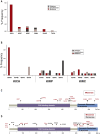Interaction of germline variants in a family with a history of early-onset clear cell renal cell carcinoma
- PMID: 30680959
- PMCID: PMC6418363
- DOI: 10.1002/mgg3.556
Interaction of germline variants in a family with a history of early-onset clear cell renal cell carcinoma
Abstract
Background: Identification of genetic factors causing predisposition to renal cell carcinoma has helped improve screening, early detection, and patient survival.
Methods: We report the characterization of a proband with renal and thyroid cancers and a family history of renal and other cancers by whole-exome sequencing (WES), coupled with WES analysis of germline DNA from additional affected and unaffected family members.
Results: This work identified multiple predicted protein-damaging variants relevant to the pattern of inherited cancer risk. Among these, the proband and an affected brother each had a heterozygous Ala45Thr variant in SDHA, a component of the succinate dehydrogenase (SDH) complex. SDH defects are associated with mitochondrial disorders and risk for various cancers; immunochemical analysis indicated loss of SDHB protein expression in the patient's tumor, compatible with SDH deficiency. Integrated analysis of public databases and structural predictions indicated that the two affected individuals also had additional variants in genes including TGFB2, TRAP1, PARP1, and EGF, each potentially relevant to cancer risk alone or in conjunction with the SDHA variant. In addition, allelic imbalances of PARP1 and TGFB2 were detected in the tumor of the proband.
Conclusion: Together, these data suggest the possibility of risk associated with interaction of two or more variants.
Keywords: cancer risk; germline; renal cell carcinoma; succinate dehydrogenase complex; variant interaction; variants of uncertain significance.
© 2019 The Authors. Molecular Genetics & Genomic Medicine published by Wiley Periodicals, Inc.
Conflict of interest statement
None declared.
Figures






Similar articles
-
Single nucleotide variants of succinate dehydrogenase A gene in renal cell carcinoma.Cancer Sci. 2021 Aug;112(8):3375-3387. doi: 10.1111/cas.14977. Epub 2021 Jun 17. Cancer Sci. 2021. PMID: 34014604 Free PMC article.
-
Renal carcinoma associated with a novel succinate dehydrogenase A mutation: a case report and review of literature of a rare subtype of renal carcinoma.Hum Pathol. 2015 Dec;46(12):1951-5. doi: 10.1016/j.humpath.2015.07.027. Epub 2015 Sep 5. Hum Pathol. 2015. PMID: 26476567 Review.
-
Succinate dehydrogenase kidney cancer: an aggressive example of the Warburg effect in cancer.J Urol. 2012 Dec;188(6):2063-71. doi: 10.1016/j.juro.2012.08.030. Epub 2012 Oct 18. J Urol. 2012. PMID: 23083876 Free PMC article.
-
A Novel SDHA-deficient Renal Cell Carcinoma Revealed by Comprehensive Genomic Profiling.Am J Surg Pathol. 2015 Jun;39(6):858-63. doi: 10.1097/PAS.0000000000000403. Am J Surg Pathol. 2015. PMID: 25724004
-
Review of succinate dehydrogenase-deficient renal cell carcinoma with focus on clinical and pathobiological aspects.Pol J Pathol. 2016 Mar;67(1):3-7. doi: 10.5114/pjp.2016.59227. Pol J Pathol. 2016. PMID: 27179267 Review.
Cited by
-
MicroRNA Processing Pathway-Based Polygenic Score for Clear Cell Renal Cell Carcinoma in the Volga-Ural Region Populations of Eurasian Continent.Genes (Basel). 2022 Jul 20;13(7):1281. doi: 10.3390/genes13071281. Genes (Basel). 2022. PMID: 35886064 Free PMC article.
-
Comprehensive overview of how to fade into succinate dehydrogenase dysregulation in cancer cells by naringenin-loaded chitosan nanoparticles.Genes Nutr. 2024 May 27;19(1):10. doi: 10.1186/s12263-024-00740-x. Genes Nutr. 2024. PMID: 38802732 Free PMC article. Review.
-
Identification of mortality-risk-related missense variant for renal clear cell carcinoma using deep learning.Ther Adv Chronic Dis. 2021 Feb 15;12:2040622321992624. doi: 10.1177/2040622321992624. eCollection 2021. Ther Adv Chronic Dis. 2021. PMID: 33643601 Free PMC article.
-
Candidate variants in DNA replication and repair genes in early-onset renal cell carcinoma patients referred for germline testing.BMC Genomics. 2023 Apr 24;24(1):212. doi: 10.1186/s12864-023-09310-8. BMC Genomics. 2023. PMID: 37095444 Free PMC article.
-
Therapeutic implications of germline vulnerabilities in DNA repair for precision oncology.Cancer Treat Rev. 2022 Mar;104:102337. doi: 10.1016/j.ctrv.2021.102337. Epub 2022 Jan 5. Cancer Treat Rev. 2022. PMID: 35051883 Free PMC article. Review.
References
-
- Bannon, A. E. , Kent, J. , Forquer, I. , Town, A. , Klug, L. R. , McCann, K. , … Corless, C. (2017). Biochemical, molecular, and clinical characterization of succinate dehydrogenase subunit A variants of unknown significance. Clinical Cancer Research, 23(21), 6733–6743. 10.1158/1078-0432.CCR-17-1397 - DOI - PMC - PubMed
-
- Belinsky, M. G. , Rink, L. , Flieder, D. B. , Jahromi, M. S. , Schiffman, J. D. , Godwin, A. K. , & Mehren, M. (2013). Overexpression of insulin‐like growth factor 1 receptor and frequent mutational inactivation of SDHA in wild‐type SDHB‐negative gastrointestinal stromal tumors. Genes, Chromosomes & Cancer, 52(2), 214–224. - PMC - PubMed
Publication types
MeSH terms
Substances
Associated data
- Actions
- Actions
- Actions
- Actions
- Actions
- Actions
- Actions
- Actions
Grants and funding
LinkOut - more resources
Full Text Sources
Medical
Miscellaneous

